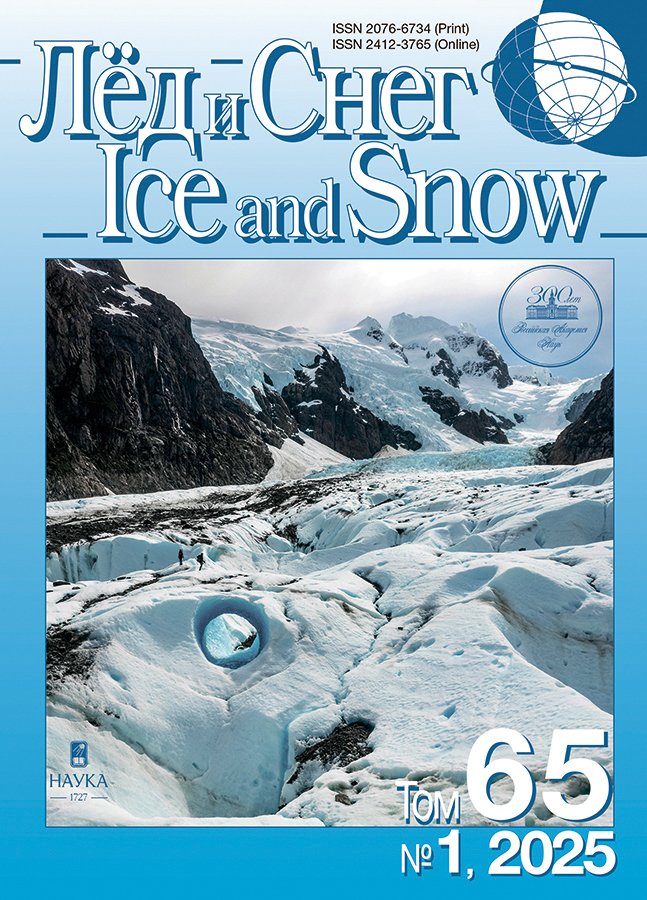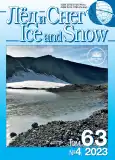Large Periglacial Lakes on the Spitsbergen (Svalbard): State in 2008–2012 and Dynamics in 1991–2022
- Authors: Chernov R.A.1, Romashova K.V.2
-
Affiliations:
- Institute of Geography, Russian Academy of Sciences
- Arctic and Antarctic Research Institute
- Issue: Vol 63, No 4 (2023)
- Pages: 525-539
- Section: Glaciers and ice sheets
- URL: https://journals.rcsi.science/2076-6734/article/view/162311
- DOI: https://doi.org/10.31857/S207667342304004X
- EDN: https://elibrary.ru/HCKBOJ
- ID: 162311
Cite item
Full Text
Abstract
Received June 1, 2023; revised July 23, 2023; accepted October 2, 2023
Approximately 3,790 lakes of various genesis existed in the Svalbard archipelago in 2008–2012, the total area of which reached 395 km2. Among them, periglacial lakes were new objects which had been formed since the beginning of the 20th century due to the deglaciation of the archipelago. We found 554 glacial lakes which areas exceeded 0.01 km2. The total area of these lakes amounted to about a half of the area of all the lakes in the archipelago – 185 km2, and two thirds of this value were large glacial lakes. The paper presents the spatial distribution of large periglacial lakes and variability of them caused by the climate warming in the archipelago. At present, there are 35 periglacial lakes (over 1 km2 in size); all of them are in contact with glaciers and the greater part of them are dammed by the terminal moraines or by a glacier itself. According to the cartographic data of the Norwegian Polar Institute and satellite images, the areas of large lakes were determined successively in 1991, 2002, 2012, and 2022. For the period from 1991 to 2012, there was a twofold increase in their area from 24.4 to 53.7 km2, but in 2012–2022 this process slowed down. On the east of the archipelago, where the inland ice is widespread, the process of the lake formation is much slower. It had been noted that on the west all large glacial lakes were formed after 1936 due to active retreat of the glaciers. At the same time, both on the north and east, most of the large glacial lakes existed prior to 1936. During the periods under consideration, changes in the areas of individual objects reached multiple values. The most large-scale changes in the lake areas were associated with the ablation of glacial fronts in contact with the lake, a glacier surge, and outbursts of a few dammed lakes. Six lakes were identified, where the water level drop reached tens of meters. Despite the slowdown in the formation of lakes in the last decade, the enlargement of lakes continues. Relative increase in the total area of the large periglacial lakes over the past 30 years on the west and east of the archipelago is in direct proportion to decreasing in glaciation of these regions. Thus, the process of formation of large periglacial lakes may be used as an indicator of climate change in the archipelago.
About the authors
R. A. Chernov
Institute of Geography, Russian Academy of Sciences
Author for correspondence.
Email: chernov@igras.ru
Russia, Moscow
K. V. Romashova
Arctic and Antarctic Research Institute
Email: chernov@igras.ru
Russia, Saint Petersburg
References
- Boronina A.S. Large outbursts of lakes of the Antarctic oases: generalization of modern knowledge. Led i Sneg. Ice and Snow. 2022, 62 (1): 141–160 [In Russian]. https://doi.org/10.31857/S2076673422010122
- Dokukin M.D., Savenyuk E.A., Bekkiev M.Yu., Kalov R.Kh., Khatkutov A.V. Evolution of lakes near the Jikiugankez glacier (Northern Elbrus region) in 1957–2020 including underground drainage channels. Led i Sneg. Ice and Snow. 2022, 62 (1): 47–62 [In Russian] https://doi.org/10.31857/S2076673422010115
- Izmailova A.V., Korneenkova N.Yu. The lake character of the territory of the Russian Federation and its determining factors Vodnie Resursy. Water resources. 2020, 47 (1): 16–25 [In Russian].
- Muravyov A.Ya., Chernov R.A. Breakthrough of the ice-dammed lake Spartakovskoye and changes in the outlet glacier of the Semenov-Tyan-Shansky dome in 2021 (Severnaya Zemlya). Led i Sneg. Ice and Snow. 2023, 63 (1): 58–68 [In Russian].
- Romashova K.V., Chernov R.A. On the Formation of New Glacial Lakes in the Basin of the Grönfjord Bay (Spitsbergen) in 1938–2010. Led i Sneg. Ice and Snow. 2022, 62 (2): 193–202 [In Russian]. https://doi.org/10.31857/S2076673422020125
- Chernov R.A., Muravyov A.Ya. Modern changes in the area of glaciers in the western part of Nordenskiöld Land (Spitsbergen archipelago). Led i Sneg. Ice and snow. 2018, 58 (4): 462–472 [In Russian].
- Chernov R.A., Muravyov A.Ya. Natural catastrophe of the ice-dammed lake Spartakovskoe on Bolshevik Island (Severnaya Zemlya). Kriosphera Zemli. Earth Cryosphere. 2020, 24 (4): 58–68 [In Russian].
- Chernov R.A., Romashova K.V. The current state of the glacial lakes of the Spitsbergen archipelago. Kriosphera Zemli. Earth Cryosphere. 2022, 26 (1): 36–45 [In Russian].
- Box J.E., Ski K. Remote sounding of Greenland supraglacial melt lakes: implications for subglacial hydraulics. Journ. of Glaciology. 2007, 53 (181): 257–265.
- Chernos M., Koppes M.N., Moore R.D. Ablation from calving and surface melt at lake-terminating Bridge Glacier, British Columbia, 1984–2013. Cryosphere. 2016, 10: 87–102.
- Hagen J.O., Liestol O., Roland E., Jørgensen T. Glacier atlas of Svalbard and Jan Mayen. Oslo: Norwegian Polar Institue. 1993: 1–169.
- Liestol O., Repp K., Wold B. Supra-glacial lakes in Spitsbergen. Nor. Geogr. Tidsskr. 1980, 34 (2): 89–92.
- Kohler J., James T.D., Murray T., Nuth C., Brandt O., Barrand N.E., Aas H.F., Luckman A. Acceleration in thinning rate on western Svalbard glaciers. Geophys. Research Letters. 2007, 34 (18): L18502.
- Mangerud J., Bolstad M., Elgersma A., Helliksen D., Landvik J.Y., Lonne I., Lycke A., Salvigsen O., Sandah T., Svendsen J. The last glacial maximum on western Svalbard. Quatern. Research. 1992, 38 (1): 1–31.
- Nuth C., Kohler J., König M., Deschwanden A., Hagen J.O., Kaab A., Moholdt G., Pettersson R. Decadal changes from a multi-temporal glacier inventory of Svalbard. The Cryosphere. 2013, 7: 1603–1621.
- Pfeffer W.T., Arendt A.A, Bliss A., Bolch T., Cogley J.G., Gardner A., Alex S., Hagen J.-O., Hock R., Kaser G., Kienholz C., Miles E.S., Moholdt G., Molg N., Paul F., Radiĉ Rastner P., Raup B.H., Rich J., Sharp Martin J. and The Randolph Consortium. The Randolph Glacier Inventory: A globally complete inventory of glaciers. Journ. of Glaciology. 2014, 60 (221): 537–552. https://doi.org/10.3189/2014JoG13J176
- Shugar D.H., Burr A., Haritashya U.K., Kargel J.S., Watson C.S., Kennedy M.C., Bevington A.R., Betts R.A., Harrison S., Strattman K. Rapid worldwide growth of glacial lakes since 1990. Nature Climate Change. 2020, 10 (10): 939–945.
- Urbański J.A. Monitoring and classification of high Arctic lakes in the Svalbard Islands using remote sensing. Intern. Journ. of Applied Earth Observation and Geoinformation. 2022, 112: 102911.
- Watson C.S., Kargel J.S., Shugar D.H., Haritashya U.K., Schiassi E., Furfaro R. Mass loss from calving in Himalayan proglacial lakes. Front. Earth Sci. 2020, 7: 342. https://doi.org/10.3389/feart.2019.00342
- Wieczorek I., Strzelecki M., Stachnik L, Yde J., Małecki J. Post-Little Ice Age glacial lake evolution in Svalbard: Inventory of lake changes and lake types. Journ. of Glaciology. 2023, 1: 1–17. https://doi.org/10.1017/jog.2023.34
- Zhang G., Yao T., Xie H., Wang W., Yang W. An inventory of glacial lakes in the Third Pole region and their changes in response to global warming. Glob. Planet. Change. 2015, 131: 48–157.
- Zang G., Rounce D., Bolch T., Chen W. Underestimated mass loss from lake-terminating glaciers in the greater Himalaya. Nature Geoscience. 2023, 16 (4): 1–6. https://doi.org/10.1038/s41561-023-01150-1
- Zhang G., Yao T., Shum C.K., Yi S., Yang K., Xie H., Feng W., Wang L., Behrangi A., Zang H., Wang W., Xiang Y., Yu J. Lake volume and groundwater storage variations in Tibetan Plateau’s endorheic basin. Geophysical Research Letters. 2017, 44: 5550–5560. https://doi.org/10.1002/2017GL073773.
- Cartographic materials of the Norwegian Polar Institute. Retrieved from: https://toposvalbard.npolar.no/ (Last access: January 09, 2023).
Supplementary files















